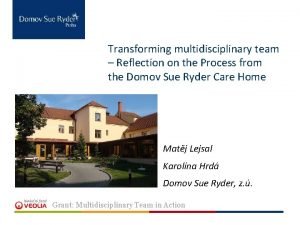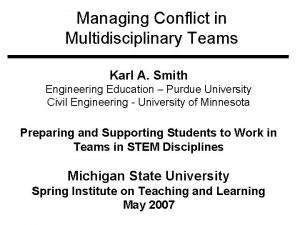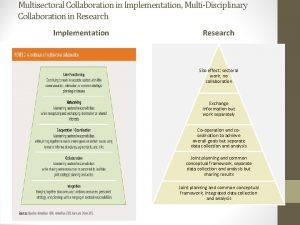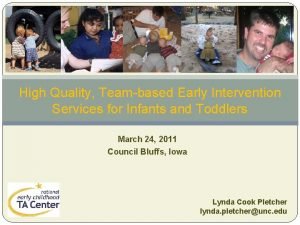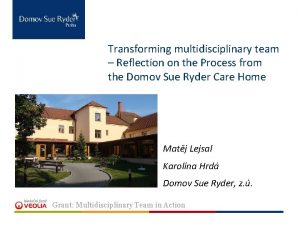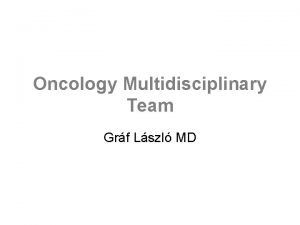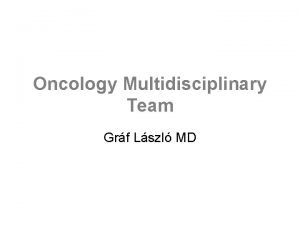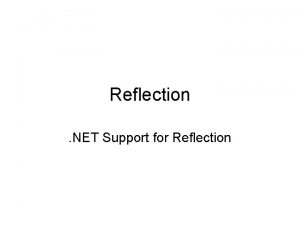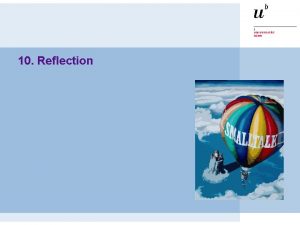Transforming multidisciplinary team Reflection on the Process from















- Slides: 15

Transforming multidisciplinary team – Reflection on the Process from the Domov Sue Ryder Care Home Matěj Lejsal Karolína Hrdá Domov Sue Ryder, z. ú. Grant: Multidisciplinary Team in Action

Case: Sue Ryder Nursing Home • Residential LTC centre – social service • Capacity: 52 residents, av. age 87, 5; median lenght of stay 1, 3 • 74% cognitive impairment; 46% middle or late stage of dementia • 66% 3 rd, 4 th grade of care allowance – high dependency • Residents with geriatric frailty syndrome, multimorbidity • No permanent doctor service • Strict distinction between health and social sector (different ministries, different legislation, no specific LTC legislation) • „Chance for dignity aging“ – person-centered care delivery

Definition of Team • Team (Mohman in Borril et al. , 2000) – group of individuals – working together to meet a particular goal or goals – own group dynamics – own culture, rules… – Interdependent relationships between members – member‘s role, sometimes even multiple – shared identity – shared decision-making – joint responsibility for the fulfillment of the goals or tasks

Multidisciplinary Team • Foreign literature no clear distinction between multi, inter, trans – disciplinary (professional) • Following the most frequent terminology in social services in the Czech Republic, we use the term Multidisciplinary team collaboration – Multidisciplinary cooperation exists if two or more social and health professions work together in a team (Booth et al. , 2008, p. 8) – Exists within context of broader organizational context (Tyler, Parker, 2011), more teams in one organization (not necessary MDTs)

Different forms of a multidisciplinary team • Context of a care home – different goals, different arrangements of multidisciplinary team Management - MDT Operational - MDT Case MDT

Why we start? • External influence – Nurse shortage – Flexibility in service delivery providing (3 2 wards) • Internal need – Strenghtening the role of social work in the organization – Higher flexibility in care delivery – Capacity for quality of care development

Original MDT architecture Ward Nurse – manager Nurses Carers Care helpers Social worker Physiotherapist Occupational therapist Nutrition therapist

MDT architecture – pros and cons • Simple structure • Communication delays • Clear responsibility • Overloaded manager • Simple decision making • Responsibility transfer „upwards“ • Simple communication channels (6) • Clear Goal Ownership • Long response to clients needs • ? mutual ability to see the perspective of each other proffesions?

NEEDS TASKS WARD NURSE - MANAGER GOAL COMPLETED TASKS GOAL OWNERSHIP I.

MDT architecture II. Nurse Social worker Carer Nutrition therapist Physitoherapist Occupational therapist

MDT architecture II. – pros and cons • Instant communication • Complex structure • Manager = facilitator • Shared responsibility • Responsibility held with team • Time demanding decisionmaking • Partnership - equality • Multiple communication channels (? ) - clashes • Professional value and dignity • GOAL OWNERSHIP

GOAL OWNERSHIP II. NEEDS ACTION GOAL 1 GOAL 2 GOAL 3 GOAL 4 GOAL 5 GOAL 6 RESULT?

GOAL OWNERSHIP II. NEEDS RISK OF COMPETING/CLASHING GOALS AND ACTIONS ACTION GOAL 1 GOAL 2 GOAL 3 GOAL 4 GOAL 5 GOAL 6 RISK OF „EXPERT COMPETITION“ RESULT?

NEW CHALLENGES • Understanding each others professions perspective • On-going verification of the GOAL with the resident – response time • Sharing vision, goals, plans with other team members • Solution in the place of origin • Competence of managers to facilitate • Relevant tools • Communication – dialog, discussion, shared terminology

Sources • Borril et al. Team Working and Effectivness in Health Care. Available at: http: //homepages. inf. ed. ac. uk/jeanc/DOH-glossy-brochure. pdf • Smith et al. Intedisciplinary Management Tool – Workbook. 2012. Available at: https: //www. researchgate. net/publication/234093973_The_Inte rdisciplinary_Management_Tool • TYLER, Denise A. ; PARKER, Victoria A. Staff Teamwork in Long-Term Care Facilities. The Influence of Management Style, Training, and Feedback. Research in gerontological nursing, 2011, 4. 2: 135 -146. • WILSON, Valerie; PIRIE, Anne. Multidisciplinary teamworking indicators of good practice. Scottish Council for Research in Education, 2000. • SFECTU, Raluca. Collaborative practices in mental health care: multidisciplinary teamwork or inter-professional collaboration groups? Management in sanatate, 2013, 17. 2: 21 -24.
 Multidisciplinary team pros and cons
Multidisciplinary team pros and cons Multidisciplinary software development team
Multidisciplinary software development team Regular reflection
Regular reflection Multidisciplinary nature of environmental studies
Multidisciplinary nature of environmental studies Multidisciplinary
Multidisciplinary Multidisciplinary vs interdisciplinary
Multidisciplinary vs interdisciplinary Multidisciplinary interdisciplinary and transdisciplinary
Multidisciplinary interdisciplinary and transdisciplinary Sunderlal bahuguna quotes malayalam
Sunderlal bahuguna quotes malayalam Conflict in multidisciplinary teams
Conflict in multidisciplinary teams Multisectoral and multidisciplinary
Multisectoral and multidisciplinary Interdisciplinary multidisciplinary transdisciplinary
Interdisciplinary multidisciplinary transdisciplinary Multidisciplinary studies epcc
Multidisciplinary studies epcc Team dashboard ct
Team dashboard ct Team project reflection
Team project reflection A burning candle is in the process of transforming -
A burning candle is in the process of transforming - Team spirit becomes team infatuation
Team spirit becomes team infatuation
